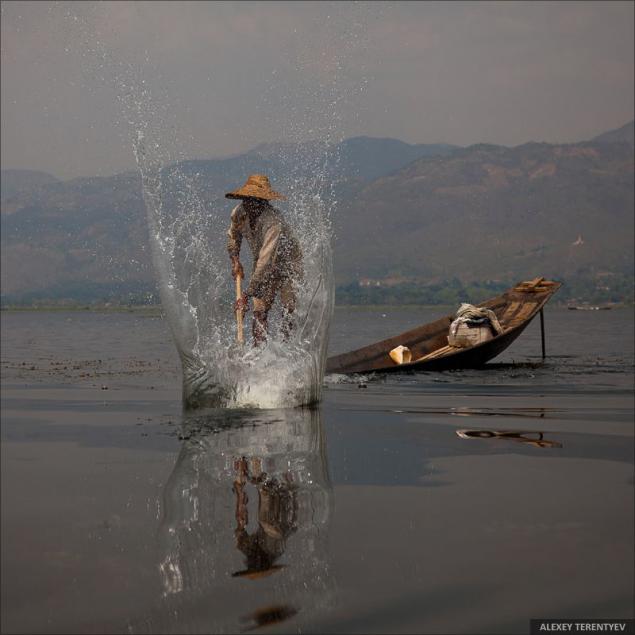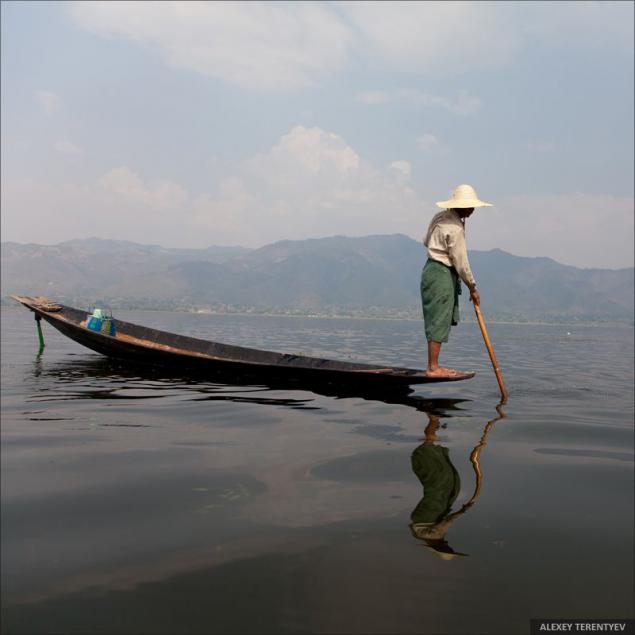1193
Boats to Myanmar
Water - this is life. So it was and always will be. Water gives food and rescues of thirst and drought. There is the sea, river or lake - and then there is the fish, and we will not stay hungry. As long as there is water, we have much to water their livestock, and so there will be meat and milk. As long as there is water, we have much to irrigate our crops, and thus we will have bread.

But water is not only earthly food, water - and even spiritual food. It is impossible beauty of sunsets and sunrises, this is the magic water that can wash away all the fears of the problems is the school a harmonious life of man and nature, the attention to the animals and care for them, it is the tendency to contemplation worthy of Buddhist meditation, and a school of courage and mutual support.

Of course, living on the water, we quickly lose sight of the beauty and harmony of the world, but that does not mean that the world ceases to affect us. Not by chance the tribes living on the water is always at least a little, but differed from their neighbors' land. Now I want to share photos of residents of Myanmar, who devoted his life to the water. Most of the staff is made on Inle Lake and Sangkar center of the country.

The main lesson, if you live on the water, it is fishing. And Myanmar is no exception. The fish are caught almost everyone, and with the smallest age. Catch nets, nets, pots, fishing poles, all sorts of devices, not just hands. And if by chance you come across a person who is not a fisherman, then rest assured, his father, brothers and friends are bound to be fishermen.

Despite the fact that water brings people together, there is still much for the separation of villages and peoples. And many of them have their own characteristics. For example, the famous Inle fishermen who row with one leg. More so rowing is not anywhere else. Even on a nearby lake in a different way. Rowing, I must say not much leg as the body using a leg as a lever.

However, I have never met to rowing two paddles sitting in the middle of the boat, as is the case with us. Fisherman always sits at the stern and one oar rowing - never two. In this part of the boat is so small, and the distance from the water to the sides so minimal that it is not clear how they are kept afloat.

In addition to the paddle mandatory attribute is a long bamboo pole - the water level is not always high, and run aground - a common occurrence. Here comes in a bamboo pole. In general, bamboo has a truly unique properties - surprisingly durable, flexible, does not decay in the water. But in Myanmar is also increasing at every step.

If you want to take a boat, the boatman will tell anyone that it is necessary to return home before dark because the dark no one swims. This is not quite true. Fishermen know every inch of the lake and can swim blindfolded - Darkness is not an obstacle for them. And fishing begins before dawn and ends after sunset.

As I said, on the lake you can find a variety of accessories for fishing. I can not even say that the more photogenic, the network in the form of a cone or a small network with weights, each time you want to throw, standing in the boat. In fairness, I will say that such networks are becoming rarer and rarer. And the most common conventional networks, which are put in the water, and then slowly and gets checked for fish. However, that does not rely on chance, some fishermen actively help fish get to him at dinner, forcing its network strong blows oars in the water. Now I can say with certainty that the fishing can be very not dull occupation that requires good physical shape. And watch the actions of the fishermen can spend hours ...

Inle Lake and the surrounding lakes are a Reserve. It is found many rare birds. By the way, even in the hotel on the table, next to the tea set we found -putevoditel book "Birds of Myanmar" and a large pair of binoculars in leather case. However, it is not about the hotel. Protection is not confined to birds, but also all the plants. The photo Glade of beautiful flowers. But it is not so. That's all the water flow, which provides the only access to the boats located on the shore of the village. Plants floating in the water, but together form a mass so dense that it becomes impassable for boats. However, to go on it too does not work, then find yourself in the water. And the locals patiently free ducts, long sticks pushing floating bushes in the middle of the lake.

Life on the water is not limited to fishing. On Inle can be found floating villages, houses on stilts or even floating gardens. However, not all the fishing villages are on the water, many humbly take their place on the beach. And for the convenience of building long bridges, many meters stretching into the distance of the lake. Bridge serves as a parking lot for fishing boats out on him fishermen, as the water level in the lake can vary greatly, and their wives still meet on a bridge at sunset of their husbands returning home with their catch.



The animals are very fond of, and bathe every day. In the evening, the cows and buffaloes themselves with great pleasure immersed in the cool water of the lake to cool off a bit. However, caring home this is not calm, and hard namyvayut animals something like washing powder - as the civilization comes to this remote region.






Life on the water: most of the time on boats. And how else, if from the house to the garden need to get on the water :)


And in this house someone lives. However, most such homes combined in the village.

Showers nowhere. Wash all on the street. One of the boats, some on the beach, lathering shampoo head and then carefully pouring himself out of a jug or basin. Always wash clothes. While most of life takes place on the shore, the people of Myanmar are very modest, I would say shy. Women always are wrapped tightly in a long dress. And when we wanted to take a picture of a fisherman, who was in swimming trunks and T-shirt, he shyly climbed into the water there, so we did not see, put on pants, and only then agreed on the photo.







There must be a duct. If you do not push all the flowers in the lake, the boat will not be able to approach the shore.



In conclusion, a few sunsets over the lake. Fishermen see them every day :)



Source: prophotos-ru.livejournal.com

But water is not only earthly food, water - and even spiritual food. It is impossible beauty of sunsets and sunrises, this is the magic water that can wash away all the fears of the problems is the school a harmonious life of man and nature, the attention to the animals and care for them, it is the tendency to contemplation worthy of Buddhist meditation, and a school of courage and mutual support.

Of course, living on the water, we quickly lose sight of the beauty and harmony of the world, but that does not mean that the world ceases to affect us. Not by chance the tribes living on the water is always at least a little, but differed from their neighbors' land. Now I want to share photos of residents of Myanmar, who devoted his life to the water. Most of the staff is made on Inle Lake and Sangkar center of the country.

The main lesson, if you live on the water, it is fishing. And Myanmar is no exception. The fish are caught almost everyone, and with the smallest age. Catch nets, nets, pots, fishing poles, all sorts of devices, not just hands. And if by chance you come across a person who is not a fisherman, then rest assured, his father, brothers and friends are bound to be fishermen.

Despite the fact that water brings people together, there is still much for the separation of villages and peoples. And many of them have their own characteristics. For example, the famous Inle fishermen who row with one leg. More so rowing is not anywhere else. Even on a nearby lake in a different way. Rowing, I must say not much leg as the body using a leg as a lever.

However, I have never met to rowing two paddles sitting in the middle of the boat, as is the case with us. Fisherman always sits at the stern and one oar rowing - never two. In this part of the boat is so small, and the distance from the water to the sides so minimal that it is not clear how they are kept afloat.

In addition to the paddle mandatory attribute is a long bamboo pole - the water level is not always high, and run aground - a common occurrence. Here comes in a bamboo pole. In general, bamboo has a truly unique properties - surprisingly durable, flexible, does not decay in the water. But in Myanmar is also increasing at every step.

If you want to take a boat, the boatman will tell anyone that it is necessary to return home before dark because the dark no one swims. This is not quite true. Fishermen know every inch of the lake and can swim blindfolded - Darkness is not an obstacle for them. And fishing begins before dawn and ends after sunset.

As I said, on the lake you can find a variety of accessories for fishing. I can not even say that the more photogenic, the network in the form of a cone or a small network with weights, each time you want to throw, standing in the boat. In fairness, I will say that such networks are becoming rarer and rarer. And the most common conventional networks, which are put in the water, and then slowly and gets checked for fish. However, that does not rely on chance, some fishermen actively help fish get to him at dinner, forcing its network strong blows oars in the water. Now I can say with certainty that the fishing can be very not dull occupation that requires good physical shape. And watch the actions of the fishermen can spend hours ...

Inle Lake and the surrounding lakes are a Reserve. It is found many rare birds. By the way, even in the hotel on the table, next to the tea set we found -putevoditel book "Birds of Myanmar" and a large pair of binoculars in leather case. However, it is not about the hotel. Protection is not confined to birds, but also all the plants. The photo Glade of beautiful flowers. But it is not so. That's all the water flow, which provides the only access to the boats located on the shore of the village. Plants floating in the water, but together form a mass so dense that it becomes impassable for boats. However, to go on it too does not work, then find yourself in the water. And the locals patiently free ducts, long sticks pushing floating bushes in the middle of the lake.

Life on the water is not limited to fishing. On Inle can be found floating villages, houses on stilts or even floating gardens. However, not all the fishing villages are on the water, many humbly take their place on the beach. And for the convenience of building long bridges, many meters stretching into the distance of the lake. Bridge serves as a parking lot for fishing boats out on him fishermen, as the water level in the lake can vary greatly, and their wives still meet on a bridge at sunset of their husbands returning home with their catch.



The animals are very fond of, and bathe every day. In the evening, the cows and buffaloes themselves with great pleasure immersed in the cool water of the lake to cool off a bit. However, caring home this is not calm, and hard namyvayut animals something like washing powder - as the civilization comes to this remote region.






Life on the water: most of the time on boats. And how else, if from the house to the garden need to get on the water :)


And in this house someone lives. However, most such homes combined in the village.

Showers nowhere. Wash all on the street. One of the boats, some on the beach, lathering shampoo head and then carefully pouring himself out of a jug or basin. Always wash clothes. While most of life takes place on the shore, the people of Myanmar are very modest, I would say shy. Women always are wrapped tightly in a long dress. And when we wanted to take a picture of a fisherman, who was in swimming trunks and T-shirt, he shyly climbed into the water there, so we did not see, put on pants, and only then agreed on the photo.







There must be a duct. If you do not push all the flowers in the lake, the boat will not be able to approach the shore.



In conclusion, a few sunsets over the lake. Fishermen see them every day :)



Source: prophotos-ru.livejournal.com























